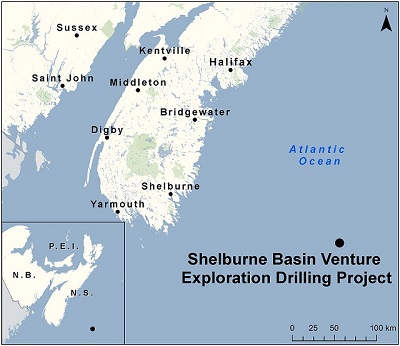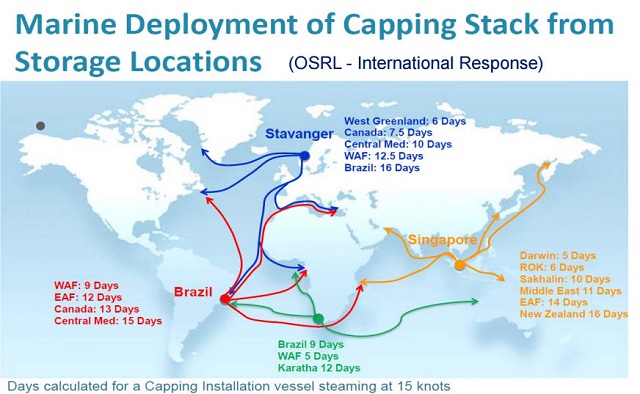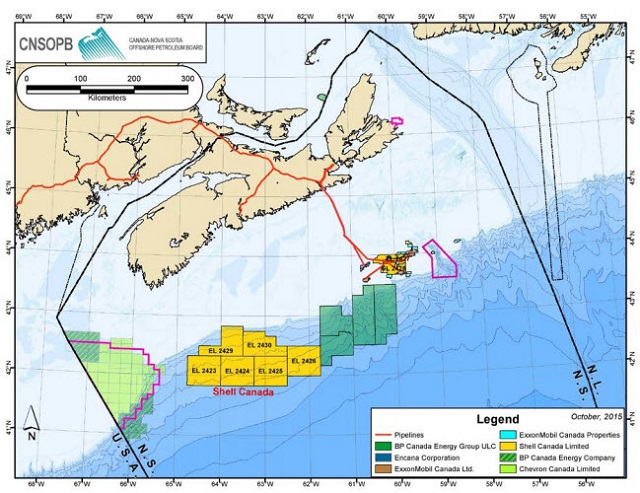Shell Canada's Offshore Drilling - Reasonable Precautions
The Canada-Nova Scotia Offshore Petroleum Board (CNSOPB) has granted permission for Shell Canada to start exploration drilling for the Shelburne Basin Venture Exploration Drilling Project 250km (155 miles) offshore from Nova Scotia. CNSOPB says the company will be taking all reasonable precautions, a view not shared by the environmental organization WWF.
“After an extensive regulatory review process, Shell Canada has demonstrated to the satisfaction of the CNSOPB that it will be taking all reasonable precautions to protect safety and the environment while carrying out the drilling program,” said Stuart Pinks, CNSOPB CEO.
 Shell Canada submitted applications earlier this year with the initial phase of the program involving the drilling of two exploratory wells. Prior to drilling the first well (Cheshire), Shell Canada must also receive an Approval to Drill a Well from the CNSOPB. The CNSOPB anticipates that this approval will be issued within the next few days. A separate approval will be required, at a later date, for the second well (Monterey Jack).
Shell Canada submitted applications earlier this year with the initial phase of the program involving the drilling of two exploratory wells. Prior to drilling the first well (Cheshire), Shell Canada must also receive an Approval to Drill a Well from the CNSOPB. The CNSOPB anticipates that this approval will be issued within the next few days. A separate approval will be required, at a later date, for the second well (Monterey Jack).
“Shell Canada’s original submission proposed that, in the unlikely event of a blow out, the deployment of a capping stack would take up to 21 days,” says Pinks. “CNSOPB required Shell Canada to review the deployment time to determine if it could be reduced. Shell Canada has responded with a more optimized schedule that indicates that a capping stack could arrive at the wellsite, should it be required, within 12 to 13 days. At the same time, Shell Canada would also deploy a second capping stack as further contingency.”

Over the past five years, CNSOPB has imposed more stringent requirements that are being implemented by Shell Canada including significant improvements to the blowout preventer. “With the stringent requirements now in place for blowout preventers, independent well examiners, real time monitoring and CNSOPB’s deep water drilling oversight plan, all new requirements since the Macondo incident in 2010, we are confident that all reasonable precautions to protect safety and the environment have been taken,” said Pinks.
WWF Recalls Alaska
Environmental organization WWF said the decision came in “stark contrast” to the recent U.S. ruling in Alaska. In order to get Arctic drilling permits, Shell was required to maintain a capping stack in a ready-to-deploy state on the support vessel Fennica. This enabled a 24 hour response to a loss of well control incident.
WWF stated: “The Canadian Environmental Assessment Agency, the body responsible for federal environmental impact assessments, claims that forcing Shell to apply capping technology within 24 hours in the Shelburne Basin, off the coast of Nova Scotia, would make the company’s exploratory work “prohibitively expensive.”
“WWF-Canada works to ensure offshore oil and gas activities in Canadian waters are carried out in a safe and responsible manner and supports the U.S. decision to require a capping stack be onsite within 24 hours of a blowout.”
“The Canada-Nova Scotia Offshore Petroleum Board has essentially given Shell Canada Ltd a license to pollute for twelve days without consequence,” said WWF Canada CEO David Miller.
“The Shelburne Basin is next to some of Canada’s richest fishing grounds and supports endangered marine wildlife including Atlantic right whales, blue whales, and leatherback turtles. Allowing an oil well blowout to continue for 12 days off the coast of Nova Scotia could have a devastating impact on the province’s marine environment, its fisheries and the people and communities who depend on them.”
Project Resources
The first phase of the exploration campaign is expected to take approximately 12 months. Shell Canada has contracted the Stena IceMAX, a dynamically positioned ice-class drill ship that is suited to the North Atlantic environment and deep-water depths.
Shell will also have one dedicated stand-by vessel, three offshore supply vessels, with one of the vessels acting as a back-up stand-by vessel, as well as dedicated Sikorsky S-92 helicopters based at the project’s heliport at Halifax Stanfield International Airport. An onshore supply base, including a supply yard, laydown area, and a quay-side mud plant, will be located at the Woodside Supply Base in Dartmouth.

The Probability of a Blowout
A detailed analysis of the probability of potential blowouts from offshore exploration wells, taking into account historical international and national spill data, was completed as part of the Environmental Impact Statement filed by Shell Canada.
In the conclusion of the analysis, the estimated probability that a specific individual exploratory well from the project (with up to seven proposed wells) would have a blowout was found to equal once in 1,287 years (or 0.00077 percent). The analysis further identified that only 41 percent of past blowout events resulted in a release of oil, as opposed to water, brine or gas. Historical information also showed that the majority of well blowouts lasted less than five days.
There have been approximately 50,000 exploratory wells drilled worldwide. There have been two instances, both in the Gulf of Mexico (in 1979 in Mexican waters and in 2010 in U.S. waters), where a blowout of an exploratory well resulted in a major spill of oil (millions of barrels) into the ocean. Other past exploratory well blowout events spilled less than 250,000 barrels (39,750 cubic meters) of oil.
Spill Trajectory Modelling
Oil spill fate and trajectory modelling and analyses were performed to help evaluate potential environmental effects of accidental spills and to enable oil spill response planning. Worst-case spill scenarios were conservatively modeled in similar environments and conditions by assuming that no response measures are put in place to minimize or reduce effects.
In the unlikely event of a major spill, oil spill response measures would be used to reduce adverse effects on the environment. Oil spill containment and recovery and shoreline protection operations would be undertaken to reduce adverse effects to marine and coastal resources and to mitigate the spill’s impacts.
The authorization to drill does not include authorization to use dispersants in case of a spill. The use of dispersants would only be considered in cases where a net environmental benefit analysis concludes that it is better for the environment to do so. By legislation, dispersants cannot be used without the approval of the CNSOPB’s Chief Conservation Officer (CCO), which would only be considered at the time of an event.
The CCO would firstly consult with experts of Environment Canada’s Environmental Emergencies Science Table, which brings together relevant experts in the field of environmental protection, as appropriate, such as response agencies, all levels of government, Aboriginal representatives, local communities, industries, environmental non-government organizations, and academic institutions. Additionally, the CCO is obligated by legislation to consult with appropriate federal and provincial Ministers before granting approval to use a dispersant.
Shell modelled a worst-case scenario of a 30-day period (with no response measures in place) of oil flow resulting from a blowout event. Shell has demonstrated that a well would be capped and contained in a shorter time period than 30 days, and as such this modeling is considered to be conservative.
This resulted in the following findings:
1. Oil generally travels to the east and northeast of spill sites
2. The likelihood of oil reaching the shore was demonstrated to be very low, demonstrably:
a. oil would need to remain on the surface for one month or more to be transported to shore;
b. predominately westerly winds would transport surface oil away from the coast; and
c. the possibility of shoreline oiling would only exist during the calmer summer months when a higher percentage of oil remains on the surface and there is a slightly increased probability of winds from the east and northeast transporting surface oil toward land.
In the unlikely event of a blowout, the probability of shoreline oiling for the modeled scenarios was found to be between 0.83 and 1.88 percent of over 400 model runs conducted for the two blowout scenarios, and was only observed during the May, June, and July model runs. It is expected that stranded oil would be highly weathered as the minimum time to shore would be between 20 and 30 days.
More information available here.
